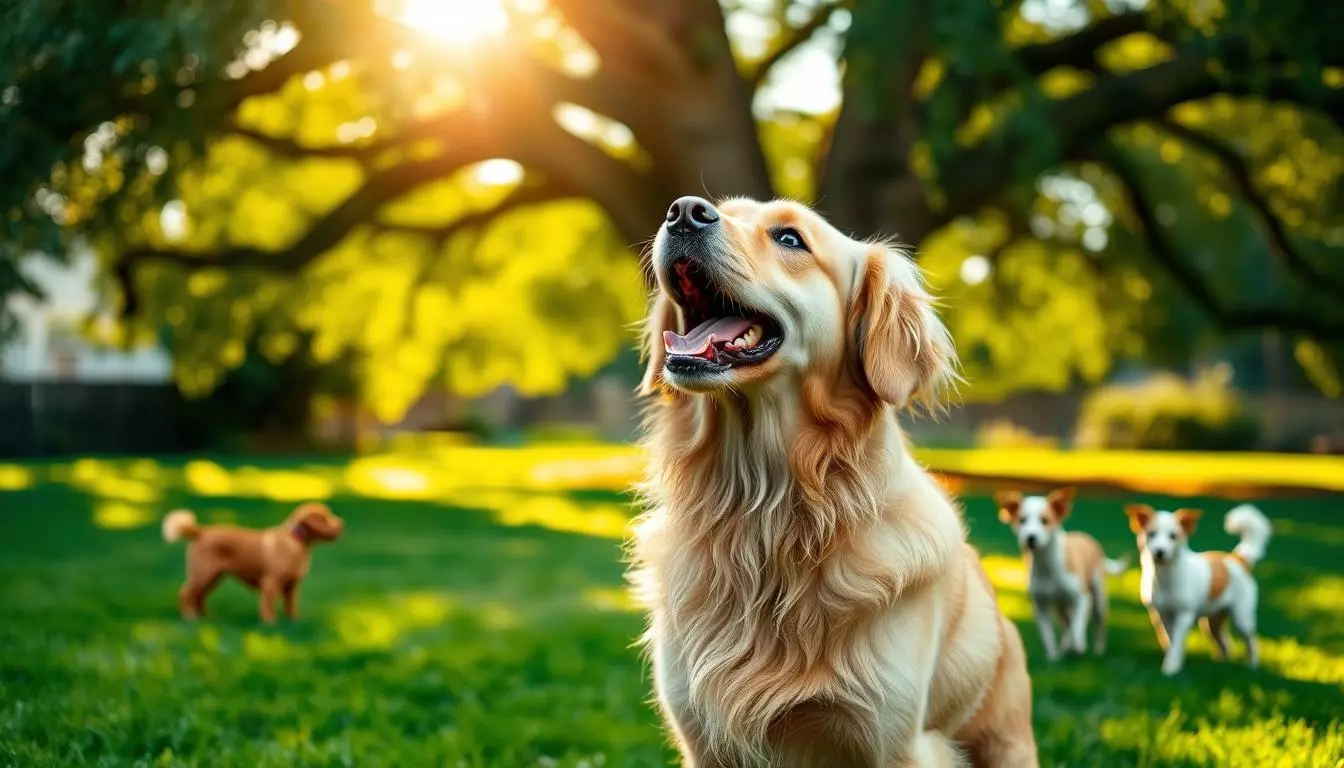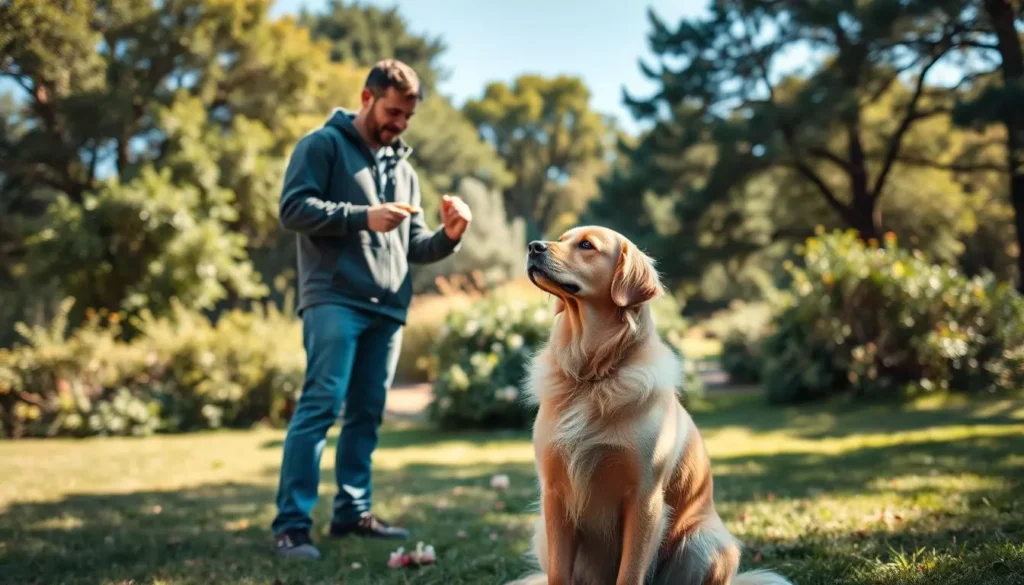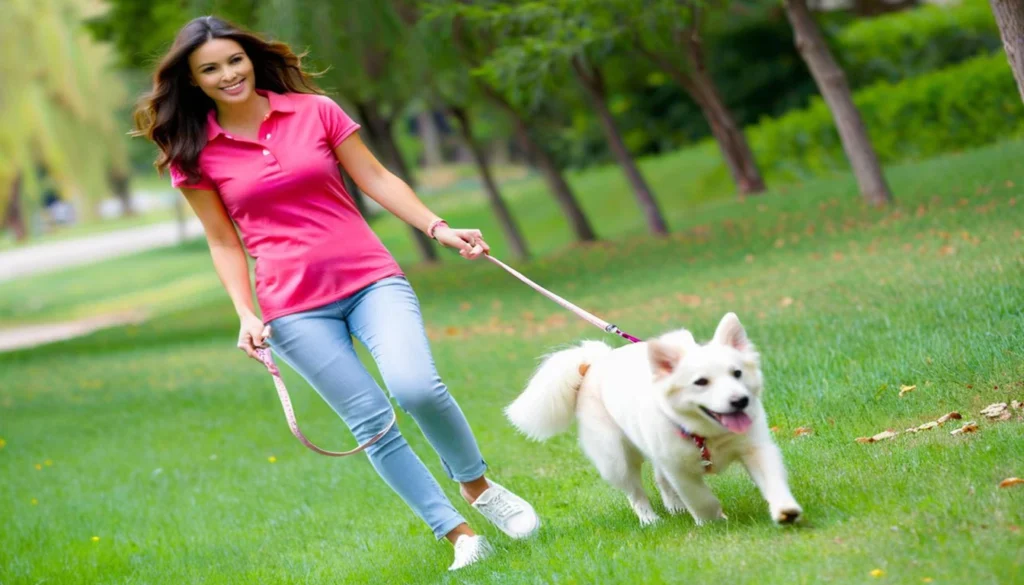Every time I step outside with my dog, I feel a mix of excitement and worry. I see my pup's body tense up and his tail stand on end. Then, he starts barking, breaking the calm of our walks.
As dog owners, we want our pets to enjoy walks. But dealing with dog barking at other dogs can be stressful. I wanted to find ways to stop my dog from barking outside for his sake and mine.
Learning why he barks helped us enjoy walks more. It improved our relationship. In this guide, I'll share strategies to help you and your dog. These tips will reduce barking when you meet other dogs.
Key Takeaways
- Understanding dog barking can reduce stress for you and your dog.
- Identifying triggers for barking is crucial in curbing the behavior.
- Utilizing positive reinforcement can create better responses.
- Calm energy during walks can help decrease barking incidents.
- Socialization and exposure are essential in reducing anxiety.
- Consistency in training techniques yields the best results.
Understanding the Nature of Dog Barking
Dogs bark to communicate in many ways. Knowing why dogs bark at other dogs helps us talk and train them better. Each bark has its own meaning, helping us understand and react correctly. It's key to know the different barks and what they mean in dog language.
Types of Barks and Their Meanings
Dogs bark in various ways to show their feelings and needs. Here are some common barks and what they mean:
| Type of Bark | Meaning | Context |
|---|---|---|
| Attention Bark | Seeking attention or play | When my dog wants to engage with me |
| Warning Bark | Alerting to potential danger | When my dog perceives a threat |
| Excited Bark | Expressing happiness and excitement | When greeting other dogs or people |
| Fearful Bark | Indicating fear or discomfort | When encountering something unsettling |
The Role of Barking in Canine Communication
Barking is crucial for dogs to communicate. It lets them share their feelings and reactions to their surroundings. By understanding this, we can better grasp our dog's behavior. This knowledge helps us tackle barking problems, making our interactions better.
Why Is My Dog Barking at Other Dogs?
It's important to know why my dog barks at other dogs for effective training. There are many reasons why they bark. Recognizing these reasons helps me manage their behavior on walks.
Common Triggers for Barking
Several things can make my dog bark at other dogs. Excitement is a big one; they bark when they see another dog. This shows they want to play.
Anxiety can also make them bark. A scared dog might bark loudly when they see another dog. Some dogs bark to protect their territory or family. Knowing these reasons helps me handle their reactions.
Emotional States and Their Influence on Barking
My dog's emotions greatly affect their barking. When they're happy, they bark with excitement. But, if they're scared or upset, they bark to defend themselves.
Understanding these emotional cues helps me respond better. I can calm them down or distract them when they bark at other dogs. Knowing what makes them bark helps me teach them better.
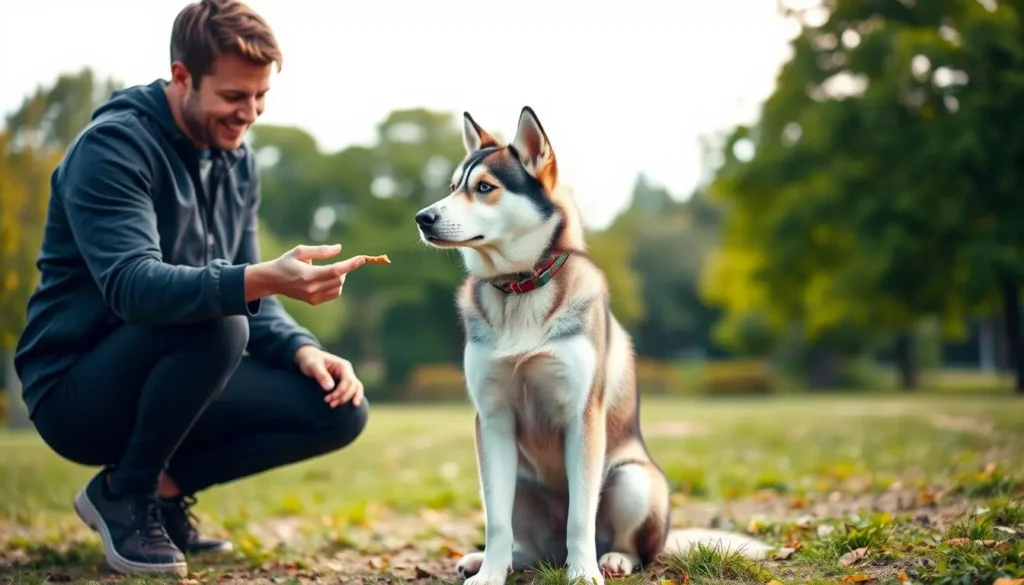
Identifying Your Dog's Barking Triggers
Understanding what makes my dog bark is key to solving the problem. By figuring out what triggers their barking, I can take steps to reduce it. These triggers fall into two main groups: physical and environmental. Both can greatly affect how a dog reacts to their surroundings.
Physical Triggers: Size and Behavior of Other Dogs
Physical factors greatly influence my dog’s barking. The size and actions of other dogs can make them bark. For example, a small dog might bark at a big, energetic dog because of fear or discomfort.
By watching how dogs interact, I can learn about these physical triggers. This knowledge helps me manage my dog’s barking better.
Environmental Triggers: Noise and Movement
Environmental factors also play a big role in barking. Loud noises, like traffic or construction, can scare or excite my dog, making them bark. Sudden movements, like someone running by, can also startle them, leading to barking.
Knowing these environmental triggers helps me create a quieter space. This way, I can reduce distractions that cause my dog to bark too much.
How to Discourage Dog Barking at Other Dogs
To stop dog barking, I teach my dog to stay calm around other dogs. This makes our walks better and strengthens our bond.
Positive Reinforcement Techniques
I reward my dog for being calm when we meet other dogs. I give treats, praise, or playtime. This shows my dog that being quiet is better than barking.
Introducing Calm Energy
Keeping calm is key to stopping dog barking. Dogs pick up on our feelings, so I stay calm and assertive. This helps my dog relax and react calmly to other dogs.
Avoiding Negative Reinforcement
Scolding or yelling can make things worse. Instead, I use positive training methods. This creates a safe and loving environment for my dog.

Effective Training Methods to Curb Barking
Using effective training methods can greatly reduce your dog's barking. Teaching basic dog commands is a key step. Commands like "sit," "stay," and "quiet" help control barking and create a calm space.
Basic Commands to Help Control Barking
Basic dog commands are essential for managing your dog's behavior. They help us understand each other better. When your dog starts barking, you can use commands like:
- Quiet: This command is key for stopping barking on cue.
- Sit: Asking your dog to sit takes their focus away from barking triggers.
- Leave it: This command helps shift your dog's attention from distractions.
Being consistent is crucial when practicing these commands.
Using a Training Clicker for Effective Communication
Clicker training for dogs makes training more precise. A clicker marks the exact moment your dog does something right. When your dog responds well to a command like "quiet," you click and give a treat. This builds a strong bond and reduces barking.
Creating a Positive Association with Other Dogs
Creating a calm environment for dogs and their owners is crucial. The engage-disengage technique is a great tool for this. It helps my dog watch other dogs without getting aggressive or barking.
The Engage-Disengage Technique
I start by picking a spot where my dog feels safe and not scared. When they see another dog, I say their name calmly and give a treat if they look at me. This helps them focus on me instead of barking.
Counter Conditioning Strategies
Counter conditioning is another effective method. I reward my dog when they see another dog from a safe distance. This reduces their anxiety. Over time, they learn that other dogs mean good things, not stress.
| Technique | Description | Benefit |
|---|---|---|
| Engage-Disengage Technique | Rewarding a dog for looking at other dogs without barking. | Builds focus and reduces barking. |
| Counter Conditioning | Offering treats while the dog observes other dogs from a distance. | Alleviates anxiety and creates positive associations. |
How to Keep My Dog from Barking at Other Dogs
To keep my dog from barking at other dogs, I need to use effective strategies. Managing the distance between my dog and other dogs is key. Keeping my dog away from situations that cause barking helps reduce stress and anxiety.
Regular exercise is also crucial. A well-exercised dog is calmer and less likely to bark too much. Socialization helps too, making my dog more comfortable around other dogs.
Managing Distance and Exposure to Other Dogs
When I see situations that might make my dog bark, I create distance. This makes my dog feel safe and less likely to bark. I use techniques like slowly getting closer to other dogs from a safe distance.
This lets my dog get used to new situations without feeling overwhelmed. As my dog becomes more confident, I can gradually reduce the distance.
Exercise and Socialization Importance
Regular exercise keeps my dog's mind and body healthy. Activities like walks, fetch, and playtime help tire them out, reducing barking. Socialization is also very important.
Playdates with other dogs in a controlled setting help my dog get used to them. This exposure builds positive associations, helping my dog bark less.
How to Train Your Dog Not to Bark at Other Dogs
Training my dog not to bark at other dogs is all about consistency in dog training. Using the same commands and methods every time helps my dog learn faster. This way, my dog knows what to expect and learns quicker.
During training, I reward my dog for good behavior. This is key to getting the best results.
The Importance of Consistency in Training
Consistency is key when training my dog. Everyone in my home uses the same commands. This helps my dog understand what's expected of him.
Unlike random rewards, consistent training gives my dog a clear path to learn. It makes my dog feel secure and confident in the training.
Using high-value treats for dogs really helps my training. These treats are super appealing and motivate my dog to listen. When my dog stays calm and doesn't bark, I give him a treat right away.
This positive reward makes my dog want to behave better. Over time, he barks less and less.
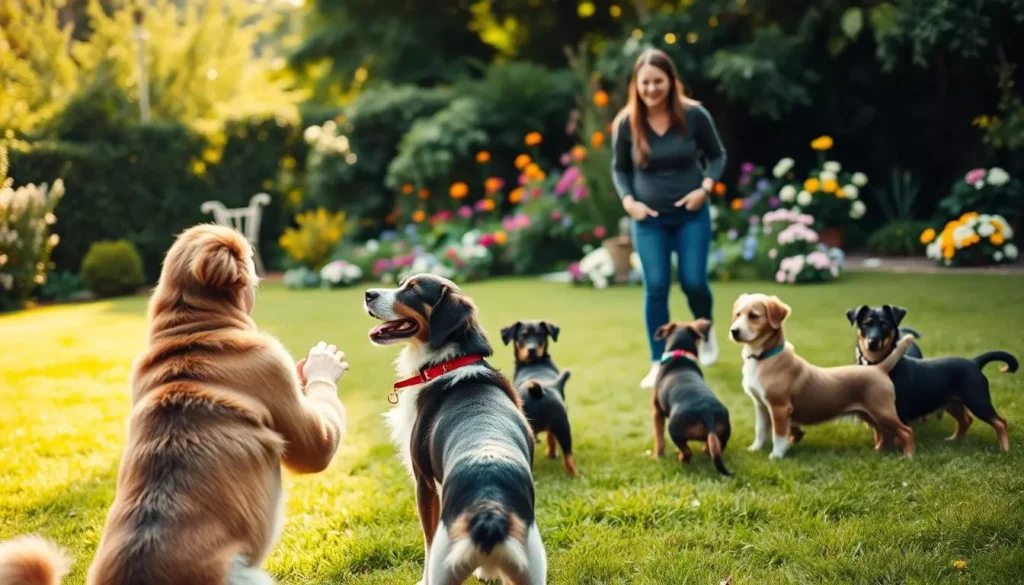
Desensitization Techniques for Overreactive Dogs
Using effective desensitization for barking can really help your dog's behavior around other dogs. It's key to use exposure techniques for dogs to manage their reactions. By slowly introducing my dog to different situations, it became more relaxed and confident.
I use gradual exposure to dog walks as a method. During these walks, I keep a safe distance from other dogs. This lets my pup watch them without feeling overwhelmed. Regular practice helps my dog get used to it, which is important.
Socialization through controlled playdates is also crucial. Playing with calm and well-behaved dogs helps my dog learn social cues. This not only improves their social skills but also reduces fear-related barking. It makes our time together more enjoyable.
Using Distractions During Walks
When I'm walking my dog, using distractions helps a lot. I carry toys and treats to keep him focused when we see other dogs. This way, we both have a better time.
Toys and Treats as Tools for Distraction
Playing with toys during walks keeps my dog busy and distracted. Treats are great rewards for staying focused. This makes our walks more fun and less likely for him to bark at other dogs.
Engaging Your Dog's Attention Elsewhere
When my dog gets upset, I use commands or tricks to shift his focus. This teaches him to stay calm around other dogs. Regular practice makes our walks more peaceful.
Walking in Less Crowded Areas
Walking my dog in quiet spots helps reduce distractions and creates a calm setting. Safe, less crowded routes make my dog feel more relaxed. This approach not only cuts down on barking but also makes our walks more enjoyable.
Finding Peaceful Routes for Training
Finding quiet paths for training is key for my dog's socialization. I look for places like quiet parks, residential streets, or nature trails. This way, I can mix up our walks and keep my dog calm and focused.
Reducing Overstimulation on Walks
Less crowded areas are essential for reducing my dog's anxiety. In these spots, my dog shows less stress. By gradually introducing them to new things in calm places, I build their confidence. This prepares them for busier areas later on.
| Location Type | Advantages | Disadvantages |
|---|---|---|
| Parks | Natural surroundings, soft ground | Potentially busy during weekends |
| Residential Streets | Low traffic, familiar sights | Limited space for exploration |
| Nature Trails | Wide open spaces, minimal distractions | Distance from home |
| Backroads | Quiet atmosphere, scenic views | Safety concerns, uneven terrain |
Maintaining Proper Gear for Dog Walks
Having the right gear is key for enjoyable and safe dog walks. The right gear keeps my pet comfortable and helps me handle unexpected situations. A good harness and leash are especially important for reactive dogs.
Choosing the Right Harness and Leash
When picking a harness and leash, I look for comfort and function. A harness spreads out the pressure, keeping my dog safe from injury. I choose harnesses with a front clip to control pulling and keep my dog's attention on me.
A sturdy leash, 4 to 6 feet long, gives me control while letting my dog explore.
Safety Considerations for Reactive Dogs
Reactive dogs need the right safety gear. I use a reliable harness that fits well to prevent slipping. Safety gear also includes a strong leash for sudden pulls.
Reflective gear is important for evening walks. It makes sure my dog and I are seen in the dark.
How to Stop Your Dog from Barking at Other Dogs
To stop your dog from barking at other dogs, you need to find out why they bark. It could be because of stress, fear, or past experiences. Knowing what scares or stresses your dog helps you train them better.
Identifying the Source of Stress or Fear
It's important to know what makes your dog anxious or scared. Watch how they react in different situations. Look for signs like tail posture or ear movement.
Keeping a diary of when your dog barks can help. It lets you see what triggers their barking. This way, you can tackle their fears one by one.
Creating Trust and Assurance During Outings
Building trust with your dog is key to less barking when they see other dogs. Always be positive and reassuring during walks. Use treats or toys to reward them for staying calm.
Start introducing new things slowly and safely. This helps your dog feel more confident. It also makes them less likely to bark.
Conclusion
Managing my dog's barking at other dogs needs a deep understanding of their triggers and behaviors. By knowing what makes them bark, I can find effective solutions. Positive reinforcement and consistent training are key to a calmer walk.
Using the strategies from this article helps reduce barking. It also improves my dog's well-being and social skills. This makes our walks and interactions more enjoyable.
I'm optimistic about improving my dog's barking with these techniques. As I keep using them, I'm sure our bond will grow stronger. This will lead to a more harmonious relationship.

